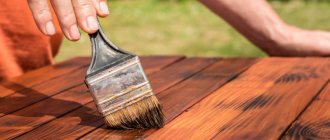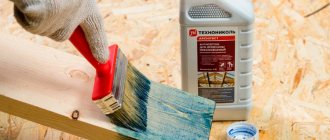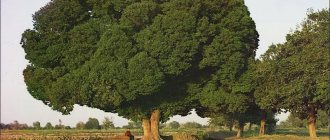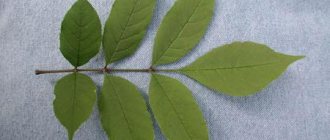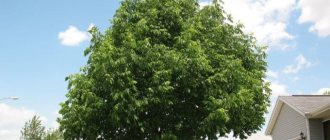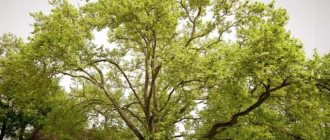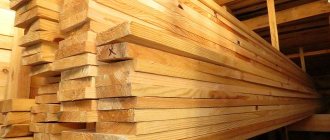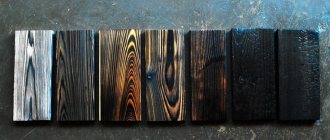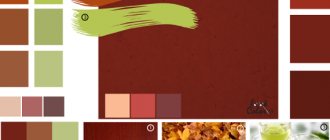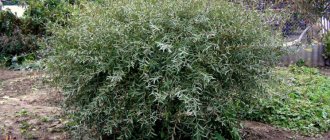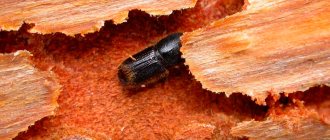Fraxinus excelsior - this is how common ash is called in botanical classification in Latin. Fraxinus is a genus of ash trees, and excelsior is an indication of belonging to a specific species (common). Since ancient times, this tree has been a symbol of wisdom, renewal and rebirth, and according to V. Dahl’s dictionary, the name of the plant is synonymous with the word “clear” (light), because its foliage easily transmits the sun’s rays.
Botanical description
Fraxinus excelsior is a slender, light-loving tree of the dicotyledonous class of the olive family, whose height is on average 20-30 m, but can reach 40 m. The trunk is up to 1 m in diameter and even more. The shape of the crown is symmetrical, directed upward, openwork (provides a loose shadow). The root system is powerful and branched, without a dominant root in well-moistened soils, or taprooted in arid areas. On average, the lifespan of a plant is about 150 years, but according to some data - up to 350 years, during which time the crown can reach 25 m in diameter.
Young seedlings are distinguished by smooth gray-green bark, which with age loses its green tint and becomes covered with cracks. The shoots in spring are covered with blackish velvety buds, from which appear lanceolate leaves with serrated edges, painted bright green on the face and a light green shade on the back. On a long petiole (up to 40 cm) there are 7-15 blades 4-9 cm long. In autumn, the crown turns bright yellow. Winter hardiness is high.
The bisexual flowers of common ash are small in size and do not have a perianth and appear before the leaves bloom. In the core of the corollas there are 2 stamens and a pistil, but it happens that there are stamens but no pistil. The flowers are collected in panicles, which grow only on last year's shoots. Typically, in the regions of the central zone, ash blooms in late April - early May.
The fruit of an ash tree is a single-seeded nut with a narrow wing (wing up to 5 cm long). At first the seeds are green, then they turn brown. Ripening occurs in August. Lionfish fall off the common ash tree very reluctantly and often remain on bare branches until spring, serving as food for birds.
The species closest to Fraxinus excelsior is the Manchurian ash (Fraxinus mandshurica). It is less tall (usually up to 25 m tall), with a straight columnar trunk and yellowish-green shoots. Lifespan can reach up to 400 years. The species is more frost-resistant, as it is distributed mainly in the northern regions.
Growing
Agricultural technology
It is highly winter-hardy and drought-resistant (excellent), quite resistant to diseases and pests (good), but in some years the leaves are damaged by ash blight, and the trunks and branches are damaged by the small ash beetle. Every year, common ash blooms in late April - early May, bears fruit well, and produces abundant self-sowing (excellent). Light-loving, grows well in moist, fertile soils, but tolerates poor and dry soils. Grows quickly, dust and gas resistant.
Reproduction
The plant reproduces by seeds .
Varieties
Nana
Spreading
The distribution area is most of Russia, including the Far East and the North Caucasus, as well as northern Africa, North America. Its neighbors in mixed broad-leaved forests are oak, maple, alder, among them the crown of the ash tree is striking in the fall with its bright yellow leaves. Individual specimens can often be found along the shores of freshwater bodies of water. The homeland of common ash is considered to be Europe and Transcaucasia. Norway is considered the northernmost place where the culture grows naturally. It is very rare to find a group of only ash trees; usually its representatives grow at a distance from each other.
Common ash
Fraxinus excelsior - this is how common ash is called in botanical classification in Latin. Fraxinus is a genus of ash trees, and excelsior is an indication of belonging to a specific species (common). Since ancient times, this tree has been a symbol of wisdom, renewal and rebirth, and according to V. Dahl’s dictionary, the name of the plant is synonymous with the word “clear” (light), because its foliage easily transmits the sun’s rays.
Planting and care
For planting seedlings, select areas in well-lit areas with fertile soil. Ash grows poorly in sandy, saline, humus-poor soils. Despite the high need for water, it is best to plant ash on a small hill with a low groundwater level. At the same time, air polluted by automobile exhausts does not harm ash, and its frost resistance is down to -40 ° C.
It is very important to plant young trees strictly vertically. If the trunk was skewed during planting, this may cause the death of the plant in the future. The minimum distance between individual specimens is 5 m, and better yet, more.
Ash – all about clear wood
Its Russian name is associated with the word “clear” and this name is well deserved. Weaker plants settle under its sun-permeable crown. And in light shade, under protection, many species develop faster.
Ash (lat. Fraxinus) is a genus of valuable woody plants of the Olive family. Its representatives are deciduous, and some subtropical species are evergreen flowering plants, found in the Northern Hemisphere of the Earth. They are found on the continents of Eurasia and North America. One species of ash grows in northern Africa. The genus includes 65 species. In Russia, 5 of them are most common (common, Pennsylvania, American, Manchurian and lanceolate).
How to recognize ash?
This is a tree with a straight trunk 25-60 m tall, rarely a shrub, with an openwork rounded crown. bark is soft, pubescent, gray with thin cracks at the bottom of the trunk. Young shoots are yellowish-green.
The wood is strong, dense, creamy white or light brown. It is spoiled by the soft, rotting core.
Ash has a powerful root system . It holds soil particles together well, so the plant is used for land reclamation. But in different environmental conditions it is not the same. With a lack of moisture and deep groundwater, the ash tree develops main, powerful lateral and adventitious roots. At the same time, the root system occupies both vertical and horizontal sections of the soil in order to more fully use the water that gets into it. If groundwater is located close, then the tree develops an anchor (surface) root system, in which it is very difficult to isolate the main root.
Reproduction
Planting material – seedlings and seeds. Despite the fact that the branches of adult specimens are usually literally strewn with seeds in the fall, it is not easy to find germinated common ash seeds among this abundance; most of them are sterile.
If the seed propagation method is chosen, then sowing is carried out in open ground as soon as the soil thaws. Shoots appear in May. In the future, caring for the seedlings consists of periodic weeding, and, if necessary, watering and loosening the soil.
For sale are 2-year-old seedlings grown in nurseries. They are planted in a permanent place in the spring, when the buds are dormant. Young trees need watering exactly until the moment when its roots go 2 m deep (takes 1-2 years), after which the tree can survive the most severe drought.
Interesting facts
There are many signs and beliefs associated with ash. Previously it was called “ash tree”, “ash tree”, “holly”. Its neighbors include elm and maple, but most often it can be found paired with oak. There is even a special sign: “If the oak tree opens its leaves earlier, then the summer will be dry.” The ancient Greeks believed that the juice from ash leaves healed wounds from poisonous snake bites. Also, many peoples dripped the sap of the branches into their eyes, believing that it gives shine to the eyes and even improves vision!
In Rus', it was believed that the bark of the tree could act as an antifever and antimalarial agent. Ash was even worshiped! They said that ash is the tree of knowledge, that it is a symbol of life and wisdom. The ancient Scandinavians believed that the symbol of a huge ash tree, which supports the vault of heaven, personifies the forces of nature. For communication, ash prefers the first half of the day. Thus, common ash (photo) is a beautiful deciduous plant.
( 1 ratings, average: 5.00 out of 5)
Diseases and pests
The greatest damage to common ash groves is caused by infections:
- Cytophomal cancer. Bark and sapwood are susceptible to impact. Threatens plants older than 10 years. The infected plant cannot regulate its temperature and dies. Affected specimens are cut down.
- Infectious necrosis. A fungal infection settles on the cambium and bark. To prevent planting, spray with iron sulfate in the spring, and with a 1% solution of Bordeaux mixture in the summer. For protective purposes, it is important to remove diseased and dead branches.
- White finely cracked butt rot. A fungus that attacks the core of the trunk and roots. Penetrates inside through damaged bark. Diagnosis is extremely difficult; usually a diseased tree is identified by its dried crown, when all that remains is to cut it down. To prevent damage to the bark, it is necessary to cover it with garden varnish.
Ash is affected by the following insects:
- Variegated ash beetle. The brown beetle resembles the May beetle, up to 3 mm long. Females lay larvae in the sapwood, and in just one summer they can kill the native plant and its neighbors. Treatments against the pine beetle are carried out in February-March with insecticides: Karate Zeon 050, Ampligo 150. Bird feeders that peck larvae and adult beetles also help.
- Emerald ash borer. It is practically not found in our country; its range is Korea, Japan, and China. Beetle larvae eat the foliage. An adult insect is up to 1 cm in length and is easily recognizable by its metallic emerald color. For prevention, at the end of spring, plantings are sprayed with chlorophos.
Recipes for various diseases
A decoction of the leaves and bark is used for liver diseases, urolithiasis, bronchopneumonia, pulmonary tuberculosis, inflammatory kidney diseases, rheumatism, polyarthritis, radiculitis, gout and dysentery, and also as an anthelmintic. To prepare a decoction of bark and leaves, pour 2 tablespoons of crushed raw materials into 1 glass of hot water, boil in a closed enamel container in a water bath for 30 minutes, cool at room temperature for 10 minutes, filter through two or three layers of gauze, squeeze and bring the volume with boiled water to original. Take 1/3 cup 3-4 times a day before meals.
Cough treatment
Collection 1. Preparation of the decoction. 20 g of chopped young sprouts are poured into a glass of boiling water, boiled for 15-20 minutes, cooled, and filtered. Take 1 tablespoon 3 times a day for persistent cough.
Meaning and Application
Common ash wood has a brown heartwood and wide white-yellowish sapwood. This color transition is smooth and wavy. The younger the plant, the more often rows of large vessels are visible in its wood. The growth rings on the saw blade are clearly visible, as are the numerous narrow medullary rays. As wood ages, it thickens and darkens.
Typical properties of the material are hardness, viscosity and elasticity, like oak. Practical tests have shown that trees grown in the north have stronger wood than those grown to the south. Interesting facts: since ancient times, dishes were made from ash, and the boards were used in shipbuilding, furniture, carriages, skis, and sleighs.
Today, common ash is used for the manufacture of sports equipment: clubs, skis, tennis rackets, etc. The beautiful texture allows you to decorate interiors with this wood. When steamed, ash bends no worse than beech. Resistance to weak acids is average, but direct contact with the soil should not be allowed. That is why benches or gazebos are not made from ash boards. Ash plywood has a beautiful pattern, which allows it to be used in the production of musical instruments and vehicle interior decoration.
Use in landscape design
Ash plays a significant role in landscaping settlements and reclamation afforestation. It has average resistance to gas pollution and smoke, so it is more suitable for planting in small cities, and in rural areas - without restrictions.
In forests, mixed ash plantations serve as a food source for ungulate mammals: goats, deer, roe deer, sheep and cattle. In addition, in spring, flowers attract pollinating insects. It is impossible to collect a lot of nectar from common ash, but its pollen is a valuable raw material from which bees produce bee bread, which is one of the most expensive beekeeping products.
In the creation of decorative garden and park ensembles, ash plays the role of a beautiful large tree. The seedlings grow quickly and provide light shade, which is very popular wherever it is not possible to plant other crops that require watering or regular rainfall.
Together with other unpretentious trees - oak, linden, poplar, alder - common ash is found almost everywhere throughout the entire territory of our vast country. A beautiful slender tree can grow for several centuries in a row, decorating the surrounding landscape.
Properties
Ash is even used in medicine . Its medicinal properties are very diverse, which allows it to be used as an antipyretic, astringent, anti-inflammatory, wound healing and diuretic. It can also relieve pain and have a laxative effect on humans. All kinds of decoctions, tinctures, powders and medicinal teas are made from it.
From a decoction of the leaves you can make compresses that will help with radiculitis, rheumatism and osteochondrosis. If you make a decoction of fresh crushed leaves, you can treat severe bruises, hematomas and wounds. These compresses relieve pain, help eliminate swelling and speed up healing. And for diseases such as cystitis, pyelonephritis, urolithiasis, you can make an infusion from the crushed roots of this magical tree.
With the help of preparations containing ash, you can cure coughs and get rid of worms. A decoction of ash roots can cure respiratory diseases. Kidney disease, dysentery, radiculitis and worms can be cured by a decoction of the leaves.
Infusions calm the nervous system, promote sleep, and help you relax. A decoction of the bark is very effective in helping to get rid of colds. Tea brewed from ash leaves has a diuretic effect on the body and removes excess fluid. Powders from seeds also have a diuretic and diaphoretic effect. And for arthritis, a mixture of different parts of the plant will help.
widespread use of ash in the form of medicines can be explained It contains active ingredients such as essential oils, tannins, bitters, coumarins, gum, resin, and flavonoids.
But, despite all its beneficial properties, this plant is considered poisonous, so you should never use it without a doctor’s prescription.
It is very important to know when to correctly collect the components for all these tinctures and decoctions. Leaves and bark must be harvested in early spring or early summer. Dry in the shade, the temperature should not exceed 40 degrees Celsius. The roots are collected in the spring, and the fruits are usually collected in the fall.
Varieties
Pendula
Botanical reference books also use the name "Pendula" and Fraxinus excelsior Pendula. This variety differs from the others in its charming weeping crown. It grows quickly and is not afraid of low temperatures. The tree also quickly adapts to city conditions, demonstrating excellent durability.
Ash grows well in moist and fertile soils. Does not tolerate compacted, dry and saline soils. This species loves light. The tree tolerates slight darkening without problems only at a young age.
Summit
Full name: Fraxinus pennsylvanica Summit. This species is actively used for landscaping the capital and other large cities. This is a slender ash tree that loves light and is adapted to the harsh Russian frosts. Tolerates the conditions of megacities remarkably well.
Nana
Ash Fraxinus excelsior Nana can be identified by its compact size and ball-shaped crown. It grows only in fertile soil and very slowly. Does not tolerate high moisture in the soil, as well as compaction and drought.
Feels great both in the sun and in the shade. For a healthy plant, you need to organize regular watering. The variety has found its application in alley plantings, for landscaping small gardens, playgrounds and other locations.
Crispa
This species is undemanding to soil, but requires regular and optimal moisture. Crispa Ash loves sunlight and tolerates short-term flooding. The crown has a regular oval shape. The color of the shoots is brownish-brown. Due to its neat appearance, the tree is often used for landscaping city yards and parks.
The texture of the leaves is matte. Color – rich green. On the reverse side the foliage is gray-green.
In the Druid horoscope
As you know, the ancient Celts were pagans. They worshiped the elements and nature: flowers, trees, herbs. The priests of the ancient Celts, the Druids, developed a special horoscope . In accordance with this horoscope, each person, depending on his date of birth, has a close connection with some tree (birch, rowan, spruce). His character and his destiny depend on which tree a person is connected to.
The ash tree occupied a central place in the Druid horoscope. According to the ancient Celtic horoscope, people born “under the sign of the ash tree” are distinguished by their rationality, truthfulness, honesty, and openness. They are always ready to help in difficult times, they are generous and magnanimous. The ancient Celts often held sacrifices under the ash tree. Perhaps this is why ash in English has the unusual name “ash” - ash, in memory of the bonfires on which the ancient Celts, the ancestors of modern Anglo-Saxons, made their sacrifices.
The ancient Celts believed that ash has the ability to absorb negative energy and transform it into positive. To do this, you just need to spend a little time next to the tree, touch its rough bark with your hand and watch how the blue skies shine through its sparse leaves.
Usage
Everything in common
Economic
Ash wood
Ash wood, due to its elasticity and strength, was used for the manufacture of military weapons and hunting tools. Ash was used to make stakes and war clubs, which were heavy, strong and elastic. The ancient Novgorodians made bows from five ash plates glued together with bone glue. Bear rods, spears, arrows, shafts are examples of hunting tools made of ash.
Carved ash utensils were very popular in ancient times. Well-dried and seasoned ash boards were used in shipbuilding. When making furniture, ash was equal in beauty of texture to ebony and mahogany. In the 19th century, ash was used to make carriages and sleighs. Skis, hoops, rocker arms were bent from ash, oars and wheel rims were made.
Nowadays, ash is used to make poles for gymnastic bars, racing oars, high-quality skis, billiard cues, and baseball bats.
The growths on ash (burls) are used to make small but valuable crafts.
Ash plywood is used for finishing furniture sets and musical instruments. The wood is used in the finishing of carriages and cars.
The tree is used for decorative, protective and reclamation afforestation. There are special decorative forms of ash that are very expressive as a component of landscape gardening ensembles. The resistance of ash to external influences determines the possibility of planting it on compacted soils, in places of air pollution with dust, soot, harmful gases - in city gardens, parks, along railways.
The flowers of various types of ash provide pollen to honey bees[4].
Food
Ash fruits contain up to 30% fat, so people have been eating them for a long time. In the 18th century in England, unripe fruits were preserved to obtain a savory seasoning for vegetable and meat dishes. In spring, ash produces sweet sap, which is used as a substitute for sucrose.
Medicine
Ash tree leaves and bark have long been used to treat chronic respiratory diseases, radiculitis, and have been used as a diuretic and laxative, as a wound-healing agent, and as a quinine substitute. The Roman physician Quintus Serenus Sammonicus in his “Medical Book” wrote about the use of ash seeds to treat dropsy, cough, and liver diseases. The ancient Greeks and Germans believed that ash tree juice could heal a person bitten by a snake.
The fruits, bark and leaves of ash are used as medicine. The leaves are harvested in early summer, and the bark in spring. The leaves contain carbohydrates, organic acids, essential oils, saponins, carotene, vitamin C, flavonoids and tannins. Carbohydrates, phenols, alkaloids, coumarins, and flavonoids were found in the bark. Ash preparations have hemostatic, tonic, antipyretic, astringent, wound healing, laxative, diuretic, antimicrobial, antispasmodic, antitussive, antirheumatic and anthelmintic effects.
The tincture of the fruit is used for varicose veins. Mannin is obtained from ash sap, which, when dried, is used in the diet of diabetic patients as a sugar substitute. But ash pollen is a strong allergen and can cause contact dermatitis[5].
Decorative configurations
Let's take a look at its decorative counterparts. Quite often they are used in landscape design.
There are several types:
- monumental, its crown has a pyramidal shape;
- low, its crown is round, ordinary, of small size, growth rate is slow;
- weeping, the branches are long, hanging down to the ground, the crown is dome-shaped, the height can reach about 8 meters.
The wood has a very beautiful texture, its core is dark, but there is a light shade on top. In density and strength it is very similar to oak bark.
Firewood from coniferous trees
Coniferous wood contains a large amount of resin, which promotes rapid and intense combustion with a large release of smoke and soot. Regular use of pine firewood contributes to the formation of thick layers of soot on the walls of the chimney.
That is why coniferous wood is practically not in demand for heating houses; it is used to kindle stoves in bathhouses. The melted hearth of pine needles fills the steam room with a classic spruce aroma, which calms the nerves and has a beneficial effect on the respiratory system. The forest pine aroma appears thanks to the essential oils present in the pine needles. When burned, spruce and pine firewood produces a characteristic crackling noise that many people enjoy.
Note that burning coniferous wood is difficult to extinguish, and the embers flying out of it make this wood the most fire hazardous. Therefore, it is best to heat a closed stove or fireplace with pine or spruce firewood.
After analyzing all existing types of wood, you can easily find the best firewood for heating stoves in your home and bathhouse. Use different tree species, find the optimal solution for a specific situation. Enjoy the pleasant aroma, warmth and comfort that burning wood firewood gives you.
Where is it used?
Furniture
Ash: photos of wood and leaves, description, varieties and interesting facts
Furniture made from natural wood does not go out of fashion. These are stylish, practical and durable products. Ash products are in great consumer demand. Furniture made from this type of wood can decorate any room in the house. With proper care, the array will retain its attractive appearance for several decades.
A set in any of the shades will look great in a classic-style kitchen. The main thing is that its color is in harmony with the flooring, walls and other objects in the room.
A spacious wall is ideal for a spacious living room. It can be made from wood of different colors. Designers have been practicing this technique for a long time. You can also install a table, chairs, wardrobe and other pieces of furniture in the room.
In order not to take up a lot of space in the hallway, it is enough to install a compact bedside table. If the size of the location allows, you can put a wardrobe there for outerwear.
Laminate
The color “ash” has not been ignored by manufacturers of flooring, in particular laminate. This version of the finishing material is in demand due to its low price and optimal performance. Laminated chipboards, which are made using ash veneer, will decorate any room in the house.
To ensure that the laminate maintains its declared characteristics, manufacturers use various impregnations. They protect the coating from damaging external influences. In addition to the protective coating, resin and other compounds are used.
Buyers note possible harmful emissions as disadvantages of wood-based panels. Substances hazardous to health may be contained in the resin
Before purchasing laminated boards, you must carefully study the documentation for the product and pay attention to the presence of toxic substances. The optimal indicator is E0.5 and E1
MDF panels are also in demand. This material is an analogue of laminated chipboard, but there are differences in composition. The amount of harmful impurities is significantly less compared to laminate.
Doors
Interior doors made of solid ash can be installed in any part of the house, including locations with high humidity. The canvases are carefully treated with special compounds. They make the natural material resistant to dampness and also prevent the growth of fungus and mold. The result is practical and stylish interior doors.
Other
The color “ash” has found its application in the manufacture of wallpaper. Thanks to innovative technologies, a pattern imitating the surface of wood is applied to the top paper layer. With this decoration, an atmosphere of comfort and peace will reign in the room.
Various decorative elements are also made from wood: frames for photographs, mirrors and paintings; stands, boxes and much more.
origin of name
In Latin this tree has the loud name fraxinus excelsior, in English it is called common ash, and in Russia and some other Slavic countries it is customary to call it “ash”. There are several versions of the origin of this name. The most common version is set out in the famous explanatory dictionary of the Russian language by Dahl. If you look into this dictionary, open the letter “I” and find the word “ash”, it will say something like this: “this is a deciduous tree, derived from the word “clear”, “clear”, “to become clear” . Most likely, the tree received this name due to the fact that the blue sky can be clearly seen through its sparse crown.
However, there is another version of this name. It is associated with ancient occult medicine. Ancient herbalists and healers believed that a decoction and infusion of the leaves had the unique property of “clearing” consciousness: a person who drinks this medicine gains the ability to predict the future. This version also looks quite plausible.
It is interesting that in the old Russian language the word “ash” was originally feminine, like most other tree names: “birch”, “aspen”, “alder”. Then this word simply changed gender. From a grammatical point of view, the word in modern Russian belongs to the second declension (to which words of the masculine and neuter gender belong) and is declined according to the rules of masculine nouns with a zero ending.

